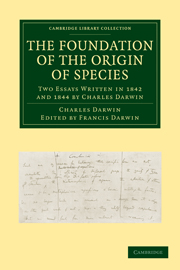Book contents
- Frontmatter
- Contents
- INTRODUCTION
- PART I
- PART II
- PART I
- CHAPTER I ON THE VARIATION OF ORGANIC BEINGS UNDER DOMESTICATION; AND ON THE PRINCIPLES OF SELECTION
- CHAPTER II ON THE VARIATION OF ORGANIC BEINGS IN A WILD STATE; ON THE NATURAL MEANS OF SELECTION; AND ON THE COMPARISON OF DOMESTIC RACES AND TRUE SPECIES
- CHAPTER III ON THE VARIATION OF INSTINCTS AND OTHER MENTAL ATTRIBUTES UNDER DOMESTICATION AND IN STATE OF NATURE; ON THE DIFFICULTIES IN THIS SUBJECT; AND ON ANALOGOUS DIFFICULTIES WITH RESPECT TO CORPOREAL STRUCTURES
- PART II ON THE EVIDENCE FAVOURABLE AND OPPOSED TO THE VIEW THAT SPECIES ARE NATURALLY FORMED RACES, DESCENDED FROM COMMON STOCKS
- INDEX
CHAPTER II - ON THE VARIATION OF ORGANIC BEINGS IN A WILD STATE; ON THE NATURAL MEANS OF SELECTION; AND ON THE COMPARISON OF DOMESTIC RACES AND TRUE SPECIES
Published online by Cambridge University Press: 07 September 2010
- Frontmatter
- Contents
- INTRODUCTION
- PART I
- PART II
- PART I
- CHAPTER I ON THE VARIATION OF ORGANIC BEINGS UNDER DOMESTICATION; AND ON THE PRINCIPLES OF SELECTION
- CHAPTER II ON THE VARIATION OF ORGANIC BEINGS IN A WILD STATE; ON THE NATURAL MEANS OF SELECTION; AND ON THE COMPARISON OF DOMESTIC RACES AND TRUE SPECIES
- CHAPTER III ON THE VARIATION OF INSTINCTS AND OTHER MENTAL ATTRIBUTES UNDER DOMESTICATION AND IN STATE OF NATURE; ON THE DIFFICULTIES IN THIS SUBJECT; AND ON ANALOGOUS DIFFICULTIES WITH RESPECT TO CORPOREAL STRUCTURES
- PART II ON THE EVIDENCE FAVOURABLE AND OPPOSED TO THE VIEW THAT SPECIES ARE NATURALLY FORMED RACES, DESCENDED FROM COMMON STOCKS
- INDEX
Summary
Having treated of variation under domestication, we now come to it in a state of nature.
Most organic beings in a state of nature vary exceedingly little: I put out of the case variations (as stunted plants &c, and sea-shells in brackish water) which are directly the effect of external agencies and which we do not know are in the breed, or are hereditary. The amount of hereditary variation is very difficult to ascertain, because naturalists (partly from the want of knowledge, and partly from the inherent difficulty of the subject) do not all agree whether certain forms are species or races. Some strongly marked races of plants, comparable with the decided sports of horticulturalists, undoubtedly exist in a state of nature, as is actually known by experiment, for instance in the primrose and cowslip, in two so-called species of dandelion, in two of foxglove, and I believe in some pines. Lamarck has observed that, as long as we confine our attention to one limited country, there is seldom much difficulty in deciding what forms to call species and what varieties; and that it is when collections flow in from all parts of the world that naturalists often feel at a loss to decide the limit of variation. Undoubtedly so it is, yet amongst British plants (and I may add land shells), which are probably better known than any in the world, the best naturalists differ very greatly in the relative proportions of what they call species and what varieties.
- Type
- Chapter
- Information
- The Foundation of the Origin of SpeciesTwo Essays Written in 1842 and 1844 by Charles Darwin, pp. 81 - 111Publisher: Cambridge University PressPrint publication year: 2009First published in: 1909

